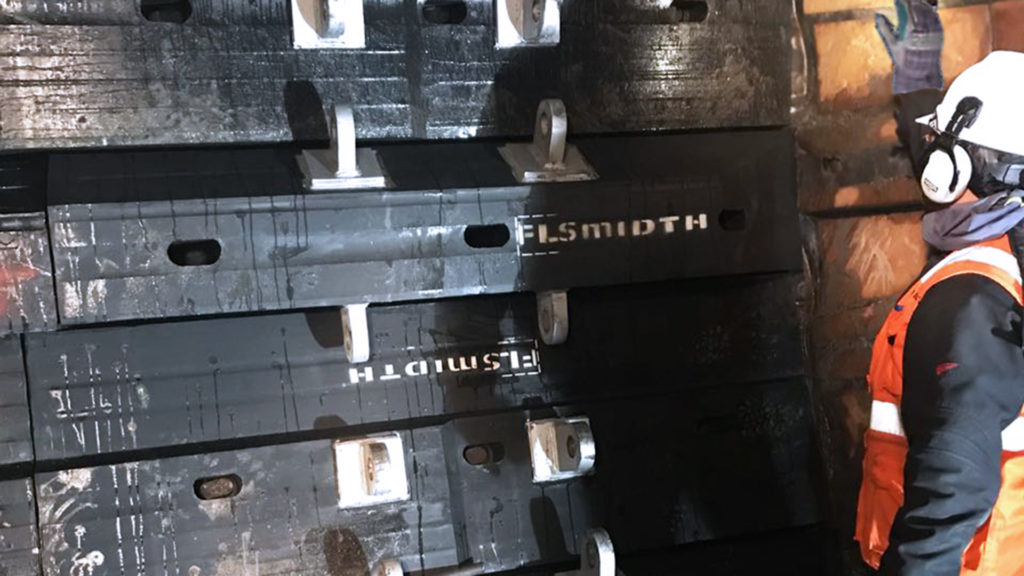Production capacity in the SAG mill is more often than not the constraining factor for an entire processing plant. Improving the throughput of a mill by even a few percentage points can thus have a significant impact on the bottom line. Replacing steel cast liners with improved composite liners is doing just that, says FLSmidth. This was the topic of a special presentation and product launch at the SME Annual Conference & Expo in Denver.
“Due to the dependence on equipment availability and a low appetite for risk in the mining industry, the progression of composite materials into large SAG mill applications has not been a fast one. But we are seeing more and more major copper and gold operations now taking advantage of composite liners in large SAG mills,” says Jack Meegan, Product Line Manager for Liners and Wear Parts in FLSmidth.
For a customer in South America, FLSmidth recently replaced a chromoly liner in a 40 ft Ø SAG mill with a rubber ceramic composite liner. This improved the slurry discharge by 6%. “Many SAG mill liner designs perform very well in their objective to achieve the desired particle size and protect the mill structure. However, no matter how well a mill is operated, and no matter how well a liner design performs, a mill is only as good as its ability to discharge the slurry out of the mill. Changing the design of liners made from composite materials can result in considerable throughput increase compared to standard steel cast liners. In this case, the benefit to the customer was of seven figures in USD in just 12 months,” says Meegan.
“Thinner mill liners result in a larger volume inside the mill. This means you can have a higher charge level. Using composite liners also cuts the weight of the liners to about 50 percent of standard steel cast liners, making it possible to work with a higher ball charge level without increasing the total weight of the mill. Both of these benefits result in a higher throughput.”
The higher throughput must be considered over longer periods of time. This means that the liners also need to be wear and tear resistant and easy, fast and safe to replace. The mill liner handler machines, designed to cantilever inside of a mill chamber during a liner change out, have limitations based on the weight of the liner components to be manipulated in place. Due to the reduction in weight, the limiting factor is no longer the weight of the liner, but the size of the opening into the mill.
FLSmidth still offers a variety of different mill liners, as each liner need to fit the specific needs of the processing plant. “To achieve the desired production plans, the operation and metallurgical managers have to consider a long sequence of equipment with a variable feed of ore hardness and ore size. It is a complicated system that has to be controlled in a professional way, and the managers always have a good picture of the plant in terms of capacity, bottlenecks, restrictions, problems and opportunities. Now, what usually happens is that if a plant is designed for 100,000 tonnes of ore per day, after the ramp up period there is always a requirement to increase the throughput with the existing equipment. This is where we as mill liners suppliers can offer help. But it requires an understanding of the specific needs of the plant as different liners suit different needs,” says Meegan.
Where upgrading to a composite liner is the right solution, the return on investment is usually within half the lifetime of the wear part. “Like all upgrades, there can be an increase in upfront costs, but the total cost of ownership value is simple to calculate. This value is manifested first by production improvements, often contributing seven figure values to our customer’s profitability. That improvement can stand on its own. However, with the improvements in downtime and reduction in safety risks, the values are even greater,” he says.
The payback time for the above-mentioned plant in South America was half the lifetime of the parts, and the mill processed more than 8 Mt. Another customer in North America with a 38 ft Ø SAG mill that made a similar change to rubber ceramic composite liners improved the slurry discharge by 7% and processed more than 19 Mt during a 12-month campaign.
“While I’m confident that cast liners, being incredibly well established, competent and proven, are not going anywhere anytime soon. I anticipate that mill liner designs will continue to incorporate an increasing amount of composites in the future. I think operators who aren’t considering the advantages of a mill liner package composed of both cast and composite parts are missing out on significant benefits,” says Meegan.











